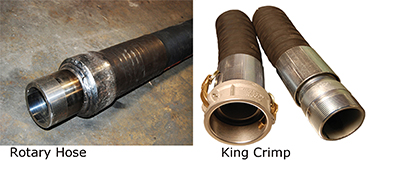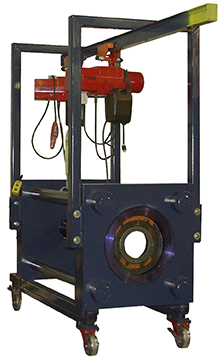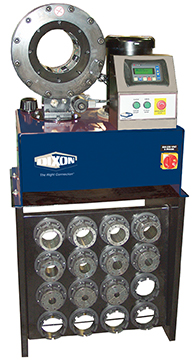Fluid Power World Contributing Writer Joyce Laird talked with Danny Parks, Product Specialist for Dixon Valve & Coupling Company, about the differences between swaging and crimping. Here’s the 411:
Swaging versus Crimping: What is the difference?
Danny Parks explained that an external swage consists of a ferrule passed through a reducing die, usually split, to bring the ferrule OD down to a predetermined size (for proper coupling retention) then, forcing the hose tube down into the stem serrations. “Crimping is the act of forming a metal sleeve or ferrule of the hose fitting with a surrounding series of die segments to compress the hose within the fitting,” he said.
 The basic difference between the two processes is that the swaging process starts at the end closest to the hose and begins reducing the ferrule moving toward the fitting, stopping about ¾ of the way up the ferrule creating a bell area creating a pocket for the excess hose to flow into. “In swaging, a machine pushes a fitting and ferrule through a fixed split die bed to reduce the OD of the ferrule, compressing the hose into the stem serrations, while a crimping machine has any number of segment dies that close around the ferrule or sleeve and reducing it to a predetermined OD. The crimping process changes the shape of the entire circumference and length simultaneously. Crimping takes a lot more force (muscle) to reduce heavy wall ferrules all at once,” Parks said.
The basic difference between the two processes is that the swaging process starts at the end closest to the hose and begins reducing the ferrule moving toward the fitting, stopping about ¾ of the way up the ferrule creating a bell area creating a pocket for the excess hose to flow into. “In swaging, a machine pushes a fitting and ferrule through a fixed split die bed to reduce the OD of the ferrule, compressing the hose into the stem serrations, while a crimping machine has any number of segment dies that close around the ferrule or sleeve and reducing it to a predetermined OD. The crimping process changes the shape of the entire circumference and length simultaneously. Crimping takes a lot more force (muscle) to reduce heavy wall ferrules all at once,” Parks said.

How to choose?
Parks noted that swaging is still the method of choice for the oil, petroleum and composites industries. “If you look at an oil rig, the piece of hose called a rotary hose used at the drill site has a 3 to 4 inch I.D. with a very thick wall, it is very heavy, normally withstands up to 5,000 psi pressure—which in the industrial world is never seen. It needs very heavy duty fittings and those fittings are connected using swaging.”
“Most industrial applications are now moving to crimping. One benefit is that crimping is automation friendly and can be integrated into any automated line using optional PLC controls and networking capabilities. Swaging has to be a hands-on operation.”
He also noted that a crimping machine is expensive equipment, so many smaller companies currently using swaging may not be ready to upgrade. “Swaging machines are hardy systems that do not wear out. We still supply the fittings that can be swaged to these companies. But for most larger companies with high volume, investing in inline automated crimpers is the growing process of choice,” he added.

Key areas to address when choosing a process
For either process, the key questions are: Which process fits the application best? What is the media, working pressure, temperature, and type of fitting for the application? Parks said that most companies offer many types of permanently attached fittings and couplings for any type of industrial application.
“In just the crimp/swage area, our original guide charts contained about 300 pages. With that many different kinds of fittings and different kinds of ferrules and different hose I.D.s and all the assembly configurations you could possibly think of, it was very confusing. We created the King Crimp program, and were able to put all of these different areas of crimp configurations together, for a large array of different fittings that all have the same basic shank design so they all use the same ferrule and the same crimp spec. It’s designed to offer different end connection options with using the same style ferrule or sleeve that has the crimp specs etched right on the ferrule or sleeve.”
The best advice Parks can give anyone in this area is to seek the expertise of a company that can connect them with the right technology. “For instance, we don’t manufacture crimpers, but we work with the equipment manufacturers and use their machine expertise and combine this with our specs and our data to make sure the final system is customized to the users exact needs. Then we conduct training on their system and teach manufacturers how to use our King Crimp system.”
“It is always best to consult with an expert. Unfortunately, with all the internet information available, it is too easy to think you have searched out all the answers online—then still make the wrong decision. Asking for help is free and it always is the right road to take. Making the wrong decision can cost you a lot in the long run.”
Dixon Valve & Coupling Company
dixonvalve.com

I would like to make my own grease lines. specifically i would like to be able to make custom length lines out of 1/8″ hose with 1/8″ male npt fittings. i will be pushing “extreme pressure grease” through these lines with a milwaukee M18 battery powered grease gun which has a 10,000 PSI max operating pressure and a max flow rate of up to 10 oz. per minute. These lines are intended to grease roller bearings that are out of reach. because they are roller bearings i dont think i will get anywhere close to the 10,000 psi that the grease gun is capable of but it would be nice to have a hose and fitting combo that could withstand that kind of pressure. lastly… i dont want to spend an arm and leg. i have no issue with making these manually with a swage tool. from what i understand a crimp tool is significantly more expensive so it may not be a practical option for me as i am not looking to start a business making grease lines but rather make my job a little easier and safer.
Actually, swaging need not be a hands-on operation. This can be automated with the right controls and the right pneumohydraulic or electric drive package. Really.